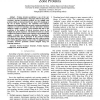57 search results - page 6 / 12 » Protein Annotation by Secondary Structure Based Alignments (... |
BMCBI
2006
13 years 7 months ago
2006
Background: The residue-wise contact order (RWCO) describes the sequence separations between the residues of interest and its contacting residues in a protein sequence. It is a ne...
NAR
2006
13 years 7 months ago
2006
The FISH server is highly accurate in identifying the family membership of domains in a query protein sequence, even in the case of very low sequence identities to known homologue...
BMCBI
2008
13 years 7 months ago
2008
Background: Recent approaches for predicting the three-dimensional (3D) structure of proteins such as de novo or fold recognition methods mostly rely on simplified energy potentia...
CIBCB
2006
IEEE
14 years 1 months ago
2006
IEEE
– Protein structure prediction is one of the core research areas in bioinformatics. This paper addresses the protein secondary structure prediction problem for the twilight zone ...
BMCBI
2005
13 years 7 months ago
2005
Background: Pairwise stochastic context-free grammars (Pair SCFGs) are powerful tools for evolutionary analysis of RNA, including simultaneous RNA sequence alignment and secondary...

